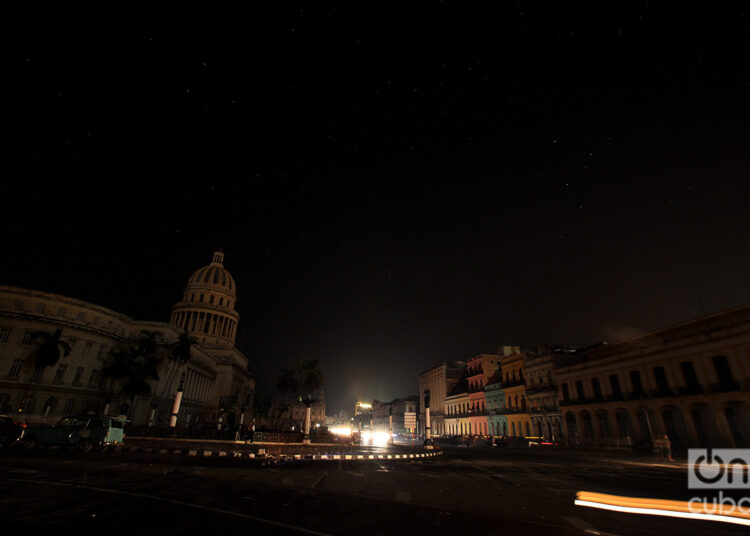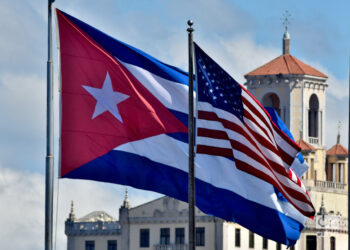Last Friday, October 18, the Cuban Electric Power System collapsed. An “unforeseen breakdown” at the Antonio Guiteras thermoelectric plant, the largest unitary generation block, caused a “total disconnection” that left the entire country in the dark.
It was not the first time that something like this had happened in recent years. In September 2022, there had already been another general outage during the passage of Hurricane Ian. Only this time there was no hurricane hitting the island, at least not yet, as Oscar would later arrive to further strain the situation in the eastern tip of the island.
It took almost five days and new total and partial power outages for the system to be fully reconnected. Hours and hours of continuous work by the electrical workers were necessary, as well as quite a few resources, while a large part of the country remained paralyzed, turned off, plunged into uncertainty.
However, less than a day before the collapse, the government had already declared a “national power emergency” in the midst of a new peak of blackouts and record figures in the generation deficit. Faced with this, it had announced a contingency plan, which included the paralysis of economic and other activities.
The total disconnection then became like “the straw that broke the camel’s back,” the sad culmination of a debacle that had been on the way, not only in the last few weeks or months, but for years; foreseeable in the opinion of quite a few experts, despite the continuous plans and strategies announced by the authorities to deal with the prolonged crisis.
How did it get to this point? What have been the paths of the collapse? What has happened in recent years that has accentuated the fragility of a key sector not only for Cuba, but for any country, for its economy and its people?
Aside from the specific breakdown and the consistent imbalance in the technical values necessary for the balance of the system that led to its total disconnection, there is an unavoidable group of factors that have led to what happened.
Below we will address several aspects, interconnected with each other, that portray the difficult panorama of the Cuban Electric Power System and explain as a whole the crisis that it is going through, the scene and catalyst of its recent collapse.
Fall in power generation
Power generation — that is, the Electric Power System’s raison d’etre — has been in free fall in recent years. Between 2018 and 2022 it was reduced by almost a quarter, according to data published last year, a dynamic that has not been able to stop since then and that has translated into a logical increase in blackouts as consumption has continued to grow.
Cuba imported more fuel to generate less electricity in 2023
A review of the reports from the Electric Union (UNE) allows us to see not only the daily effects of generation deficits ― multiplied in periods of crisis ― but also the growing inability to generate, due to different factors, which have caused falls below 2000 MW, far from the demand, which regularly exceeds 3000 MW according to official estimates.
If “until 2018 and 2019 the system operated under normal conditions with sufficient generation capacity” and “a reserve of more than 500 MW,” as explained by Minister Vicente de la O Levy, the country’s economic and financial crisis, deepened by the pandemic, radically changed the scenario, for the worse, as millions of Cubans have seen firsthand in this difficult time.
Deterioration of thermoelectric plants
The so-called thermal generation is the basis of the Cuban Electric Power System, but it suffers from the handicap of an aging and overexploited infrastructure. In addition, it has been losing part of its operations, following the withdrawal of the Mariel, Renté, Nuevitas units and the historic Tallapiedra plant in Havana. If we add to these the Felton 2, affected in 2022 by a fire, the total is 615 MW lost.
In addition, of the 15 blocks in operation, 14 have been in operation for more than 30 years and seven of them have been in operation for more than 40 years, as explained last May by Alfredo López, director of UNE, who confirmed that since 2018 no thermoelectric plant has received major maintenance. The Guiteras, for example, has already gone 13 years without any, as a result of repeated postponements in the midst of the crisis.
All of this hinders the generation capacity of these old units. “A 100 MW unit today only generates between 70 or 80 megawatts. The sum of all these deficits is in the order of 400 MW due to the years of operation, the lack of spare parts,” recently said De la O Levy, who said that the maintenance they have received in recent times seeks to “keep them alive.”
Problems with distributed generation
Thermoelectric plants are not the only ones that have seen their generation capacity reduced. The much-needed generator sets, emblems of the former Power Revolution and support for the so-called distributed generation, have also suffered the impact of the lack of parts, maintenance and fuel — both diesel and fuel oil —, which in turn has drastically affected their power production.
The generator sets’ generation plummeted by 42% between 2018 and 2022, according to official data. In November 2023, the director of UNE explained that although there were more than 2,000 MW of distributed generation in the country, only about 900 were available. However, this September the minister lowered that figure to 400 MW and admitted that the capital repair plan had not been met since 2021.
In addition to the problems of these sets, which are often started up after the recommended time without receiving maintenance, there are those suffered, for the same reasons, by the fuel shortages of the Mariel and Moa units, and even by the Turkish barges, which have also run out of fuel and whose number ― which was once eight ― has decreased after the departure of several of them from the island.
Low contribution of renewable energies
A decade has already passed since the Cuban parliament’s approval of a policy for the prospective development of renewable sources. However, despite the plans drawn up and redrawn, and the official discourse that recognizes their importance in changing the energy matrix and eliminating dependence on fossil fuels, since then little progress has been made.
At the end of 2021, the implementation of the policy was barely 47% complete, according to Rosell Guerra Campaña, director of Renewable Energies at the Ministry of Energy and Mines, and although actions have continued to be carried out since then ― especially the installation of new photovoltaic parks ― the contribution of these sources has even fallen below 5% of all electricity production in Cuba.
Lack of financing, failed investments ― such as the Ciro Redondo bioelectric plant, which has not managed to contribute what was expected ― and unsuccessful plans have conspired to seriously threaten the government’s intention to reach 2030 with 24% or more of generation based on these sources, even with the new plan underway to install 2000 MW in solar parks in a few years.
Fuel shortage
In recent years, the lack of fuel has been a sword of Damocles for the depressed power generation, at a time of very low financial availability. Although the island produces its own crude oil, it is not nearly enough and is much more corrosive than recommended. This increases the damage to the generating plants and, therefore, the unsatisfied demand for parts and maintenance.
Of the eight million tons of fuel that Cuba consumes, some five million depend on purchases on the international market, according to De La O Levy. This situation involves “gigantic expenses, of billions of dollars,” amid a significant decrease in shipments from Venezuela, the island’s main supplier for years, and from other partners such as Russia and Mexico.
To this should also be added problems with logistics once in Cuba. This includes difficulties in the storage and internal transportation of fuel, as well as the need for processing to comply with technical specifications, since “sometimes it does not comply and must be treated so that it can be consumed,” authorities have acknowledged.
Increase in electricity consumption
While electricity generation has continued to fall and in 2023 was 2.5% lower than in 2022, consumption, far from decreasing, has multiplied. Last year it grew by 8%, with significant increases in both state and residential demand. The authorities have mostly pointed to the latter, due to the increase in electrical devices in the country, despite the constant blackouts.
“When there is a power outage for many hours, the devices stop working and when the power comes back, they start working non-stop,” explained the minister, who recognizes that people need to take advantage of those moments for their household chores. According to the minister, after a power outage of more than three hours “consumption increases by 51% and these behaviors are not normal.”
The government has also pointed to the so-called “large consumers” and the private sector, which needs electricity to carry out their businesses. In response, it has increased electricity rates and insisted on saving despite the heat and the impossibility of the system to keep up with consumption. “We have a power generation limit,” admitted the director of UNE.
Impact of sanctions and increase in expenses
The insistence of the Cuban government on pointing to the U.S. embargo, which many see as a way of evading its own responsibilities, makes sense. The real impact of the sanctions on the island’s Electric Power System cannot be minimized. The damage to this sector, between March 2023 and February of this year, amounted to 388,239,830 dollars, according to official estimates from Cuba.
The difficulties repeatedly denounced by Havana include obstacles to payments, credits and bank transfers; fines to ships, shipping companies and other companies involved in the fuel trade to the island; purchases of suppliers by U.S. companies; and losses resulting from going to new and more distant markets, among other problems.
All this translates, together with the increase in global prices for freight and supplies as a result of the pandemic, into a significant increase in the expenses necessary for the maintenance of the system, especially in relation to fuel. If in 2019 Cuba spent between 150 and 170 million dollars to buy fuel, in 2022 it was 1.7 billion, a figure that has continued to grow since then.
This has happened, moreover, at a time when the island’s income has fallen significantly in the midst of the deep economic and financial crisis it is experiencing. Thus, last May the director of the UNE acknowledged that the system had not been able to have the 300 million dollars it requires ― not counting the cost of fuel ― for the optimal operation of its plants and networks.
Insufficient investment and planning problems
Finally, in the progressive deterioration of the Cuban Electric Power System and its harsh consequences ― such as the long blackouts and the recent collapse ―, a decisive weight is played by the insufficient investment derived from failed strategies and “erroneous state priorities,” in the opinion of academics and experts, without discounting the problematic plans due to their short-term vision or those ruined by unforeseen situations.
Such problems stand out more when comparing the investment in the sector with others, such as tourism. As economist Pedro Monreal noted, between 2020 and June 2024, “investment mainly associated with tourism (the sum of ‘hotels and restaurants’ and ‘business services and real estate activity’) averaged 38.9% of the country’s total investment, compared to 9.4% of investment in electricity, gas and water.”
Based on such compelling figures, Monreal believes that “the collapse of the Cuban Electric Power System highlights one of the main mistakes of investment policy in Cuba: excessive investment associated with tourism with low utilization of its capacity and neglect of the country’s dilapidated infrastructure,” while he sees the origin of this imbalance in “internal political decisions.”
His opinion is shared by other experts, such as Mauricio de Miranda, who considers it “evident” that this is a “failed” investment policy and “harmful to the interests of society.” And also for many ordinary Cubans, for whom, long before the recent collapse, and even with the government’s repeated explanations and announcements, the numbers clearly do not add up.
The recurring darkness in their homes, neighborhoods and cities speaks for itself.










